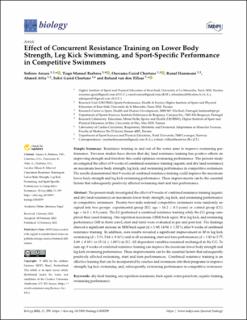Effect of concurrent resistance training on lower body strength, leg kick swimming, and sport-specific performance in competitive swimmers
Amara, Sofiene; Barbosa, Tiago Manuel; Chortane, Oussama Gaied; Hammami, Raouf; Attia, Ahmed; Chortane, Sabri Gaied; van den Tillaar, Roland Johannes Wilhelmus
Peer reviewed, Journal article
Published version

Åpne
Permanent lenke
https://hdl.handle.net/11250/3048804Utgivelsesdato
2022Metadata
Vis full innførselSamlinger
Originalversjon
Amara, S., Barbosa, T. M., Chortane, O. G., Hammami, R., Attia, A., Chortane, S. G. & van den Tillaar, R. (2022). Effect of concurrent resistance training on lower body strength, leg kick swimming, and sport-specific performance in competitive swimmers. Biology (Basel), 11(2), Article 299. doi: 10.3390/biology11020299Sammendrag
Simple Summary: Resistance training in and out of the water aims to improve swimming performance. Previous studies have shown that dry land resistance training has positive effects on improving strength and therefore this could optimize swimming performance. The present study investigated the effect of 9 weeks of combined resistance training (aquatic and dry land resistance) on maximum lower body strength, leg kick, and swimming performance in competitive swimmers. The results demonstrated that 9 weeks of combined resistance training could improve the maximum lower body strength and leg kick swimming performance. These improvements can be the essential factors that subsequently positively affected swimming start and turn performance. Abstract: The present study investigated the effect of 9 weeks of combined resistance training (aquatic and dry land resistance) on maximum lower body strength, leg kick, and swimming performance in competitive swimmers. Twenty-two male national competitive swimmers were randomly assigned into two groups: experimental group (EG: age = 16.2 ± 0.3 years) or control group (CG: age = 16.3 ± 0.3 years). The EG performed a combined resistance training while the CG group completed their usual training. One repetition maximum (1RM) back squat, 30 m leg kick, and swimming performance (100 m front crawl, start and turn) were evaluated in pre and post test. The findings showed a significant increase in 1RM back squat (d = 1.90; 14.94 ± 1.32%) after 9 weeks of combined resistance training. In addition, ours results revealed a significant improvement in 30 m leg kick swimming (d = 2.11; 5.84 ± 0.16%) and in all swimming, start and turn performances (d = 1.83 to 2.77; 2.69 ± 0.18% to 15.14 ± 1.06%) in EG. All dependent variables remained unchanged in the CG. To sum up, 9 weeks of combined resistance training can improve the maximum lower body strength and leg kick swimming performance. These improvements can be the essential factors that subsequently positively affected swimming, start and turn performances. Combined resistance training is an effective training that can be incorporated by coaches and swimmers into their programs to improve strength, leg kick swimming, and, subsequently, swimming performance in competitive swimmers.
